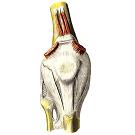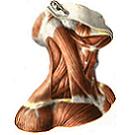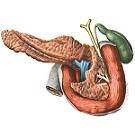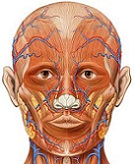Laryngeal cavity
The cavity of the larynx , cavitas laryngis, has the shape of an hourglass. The upper expanded - the vestibule of the larynx , vestibulum laryngis, extends from the entrance to the larynx, aditus laryngis, to the folds of the vestibule, plicae vestibularis. The entrance to the larynx is limited to the front by the posterior surface of the epiglottis, at the back - by the tops of the arytenoid cartilages and at the sides by the cherpalodnortal folds, plicae aryepiglotticae. Between the latter and the inner surface of the thyroid cartilage, a pear-shaped pocket is formed on both sides, a recessus piriformis.

The average narrowed part of the larynx is actually the voice apparatus, glottis, is bounded on top by folds of the vestibule, and from below by vocal folds; It has the form of a sagittally located slit. The gap between the folds of the vestibule is called the gap of the vestibule, rima vestibuli, and the gap between the vocal creases is the glottis, rima glottidis.
In the latter two departments are distinguished:
1) the inter-membranous part, pars intermembranacea, lying between the free edges of the vocal folds;
2) inter-cartilaginous part, pars intercartilaginea (respiratory part), - a wider posterior part of the glottis, entering the interval between the arytenoid cartilages. Above the glottis is an inter-head incision. It is a vertical median slit that extends on the threshold of the larynx between the two carobular cartilages and the upper ends of the arytenoid cartilages.
Part of the larynx , which lies below the level of the vocal folds, was called the podogolovoy cavity, cavitas infraglottica; Downwards it conically expands and passes into the cavity of the trachea .
Innervation: nn. Laryngei superior gives r. Internus to the mucosa above the glottis and r. Externus to m. Cricothyroideus; N. Laryngeus inferior (branch n. Laryngeus recurrens) innervates all other muscles and mucous membrane of the lower half of the larynx. Both nerves are branches of n. Vagus. From truncus sympathicus to the larynx fits n. Laryngopharyngeus.
Blood supply: a. Laryngea superior (from a. Thyroidea superior) and a. Laryngea inferior (from a. Thyroidea inferior). Venous blood flows along the veins of the same name, forming venous plexuses, and enters the vv. Thyroideae superior et inferior. Lymphatic vessels of the larynx divert lymph to nodi lymphatici cervicales profundi anterior (prelaryngeales, pretracheales, paratracheales) and laterales (jugulares).
You will be interested to read this:









Comments
When commenting on, remember that the content and tone of your message can hurt the feelings of real people, show respect and tolerance to your interlocutors even if you do not share their opinion, your behavior in the conditions of freedom of expression and anonymity provided by the Internet, changes Not only virtual, but also the real world. All comments are hidden from the index, spam is controlled.